Features of cleaning by material
To get rid of carbon deposits in the pan without damaging it, you need to take into account its composition. The material plays a major role in choosing the right product.
Take a look a selection of ideas for organizing the storage of pans.
Cast iron
Cast iron pans are one of the most durable, but whimsical options for cooking utensils. The food in them turns out to be delicious, but it is not easy to care for cast iron. Although everything is learned in comparison.
The main enemy of cast iron is water... This metal rusts quickly, so avoid prolonged soaking to reduce the risk of corrosion. Also, thoroughly wipe moisture from the inside and outside of the pot or pan every time after use and washing.
Also cast iron does not like caustic chemicals - the coating can react with them and break down, as a result of which the protective properties are reduced. Use abrasives like salt or a hard sponge instead of chemicals.
Steel
You can clean a stainless steel pan with anything: this material will endure everything! Abrasive sponges, soaking, detergents, aggressive acids and alkalis, high temperatures. Stainless steel can be boiled, washed in the dishwasher, cleaned with a scraper.
Aluminum
On the other hand, aluminum pans without a non-stick coating do not tolerate almost anything: they cannot be cleaned with metal brushes, alkalis (baking soda), acids (citric, vinegar).
Prohibited soaking and boiling. The maximum is warm water and detergent.
Teflon
A thick layer of Teflon coating improves the performance of aluminum: Teflon pans can be washed in the dishwasher, soaked for a couple of hours, cleaned with laundry soap or soda solution.
But in no case wipe the surface with an abrasive (even the smallest!) And do not use acids (acetic, citric, formic, etc.).
Ceramics
Frying pans with ceramic spraying that are popular today, like their Teflon "counterparts", are not friendly with abrasives (powders, melamine and metal sponges): therefore, they are cleaned with liquids or gels.
Ceramic coating does not like long contact with water: soaking, boiling. Soap solutions, alcohol, and gel dishwashing detergents are suitable.
The best ways to deal with carbon deposits
To remove carbon deposits from the pan, choose one of 10 methods and follow the instructions.
Take a look options for combating grease and carbon deposits in the oven.
Soda
There is a box with an orange border in almost every kitchen. Sodium bicarbonate is striking in its versatility: it is added to baked goods, used as an adsorbent, and used in the fight against soot and fat. Moreover, there are several options for using for washing pans:
- Mechanical method... Sprinkle baking soda on the bottom, add a little water until a slurry forms, rub thoroughly with the hard side of a sponge or a brush to remove any plaque.
- Temperature... Pour a liter of water into a burnt container, put on fire, bring to a boil. Then remove from the stove, quickly add a few tablespoons of baking soda - an immediate reaction will begin. Wait until the pan is completely cool, rinse with a sponge with Fairy or another product.
- Chemical... Does not require boiling, you need soda and vinegar. To remove impurities, cover them with baking soda, then fill them with diluted vinegar essence. As a result of a chemical reaction, carbon dioxide (CO2) is released, which destroys the structure of the ingrained carbon deposits.
Hydrogen peroxide
If the duet of soda and vinegar seems too dangerous, but you still want to remove old fat, try more delicate way.
Hydrogen peroxide is mixed with soda until a slurry is formed, applied to a preheated (but not red-hot!) Frying pan for 15 minutes, the mixture is removed with a sponge or rag along with dirt.
Advice! To combat heavy carbon deposits, the cleaning procedure can be repeated 2-3 times.
Review of the hostess: “I regularly use peroxide in the kitchen: mixed with baking soda, applied to a hot frying pan or saucepan, rubbed, washed off - the dishes shine like new!”.
Ammonia
This method is relatively gentle and therefore works with both steel pots and non-stick pans. All you need is a couple of tight bags and a bottle of ammonia.
Important! Work outdoors or in a well-ventilated area.
- To avoid leaks, nest one bag inside the other.
- Place the skillet inside.
- Pour in ammonium hydroxide.
- Close, shake the contents well (so that the ammonia covers the pan on all sides).
- Leave the package overnight (10-12 hours) on the balcony or take it outside.
In the morning, it remains to rinse the "brand new" frying pan and wash it with dish soap to remove the odor.
Vinegar or citric acid
Acids are excellent allies in the war against soot and grease. They are found in many kitchen and bathroom cleaning products. But buying professional sprays is not necessary - folk recipes based on citrus or vinegar essence are just as effective.
Acids work best in hot water: For cleaning, boil 15-20 g of acid in 2-3 glasses of water for a few seconds. After removing from the heat, leave to cool completely, pour out the water, wash the walls and bottom with a soft sponge.
Advice! If you want to remove carbon deposits from both sides of the pan, you need a basin. You need to dissolve the acid in it and soak the old utensils. Better yet, boil with a frying pan.
Vinegar works on the same principle: a couple of spoons are diluted in water and brought to a boil.
Activated carbon
This recipe is ideal for steel pans: grind 10 tablets into powder, slightly moisten the dishes and sprinkle on the dirt. Set aside for an hour, then rinse, scrub with a sponge if necessary.
Washing powder
Housewives often use a similar recipe to bleach towels, but few know that it is also suitable for dealing with old carbon deposits.
- Take a container larger than the one that needs to be cleaned: a basin, a bucket, a saucepan.
- Immerse a frying pan inside, fill with water.
- Add 2-3 tablespoons of washing powder and the same amount of vegetable oil.
- Stir.
- Bring to a boil and let cool.
- Rinse the cold pan with water.
- Remove residual soot with a sponge.
Laundry soap
To prepare alkaline household chemicals, rub half a bar of laundry soap, prepare 125 ml of silicate glue and 125 ml of baking soda.
Boil water in a basin / bucket, turn down the power of the burner. Add the above ingredients, stir well, immerse the problem pan. It is necessary to boil the composition for 2-5 hours: during this time the carbon deposits will soften and easily move away from the base.
Sand
If you don't like pouring something into the frying pan, try adding ... sand! Pour ordinary dry fine grains of sand to the brim and leave on low heat for 2.5 hours, stirring occasionally. After the time has elapsed, the sand is cooled and discarded, and the cleaned dishes are rinsed under running water.
Important! Work outdoors or keep windows open.
Coca Cola
There are probably no less ways to use cola than options with soda.Thanks to its high concentration of carbon dioxide and acid, Coca Cola perfectly removes rust, deposits and, of course, carbon deposits.
No special preparation is needed: pour the soda inside, bring to a boil, leave for 20 minutes, rinse. If necessary, repeat the procedure 1-2 more times.
Shumanite
When listing the best methods for soot control, one cannot fail to mention a professional remedy. It is used even in the kitchens of cafes and restaurants, and not only for dishes, but also for stoves, ovens, and hoods. Shumanite perfectly dissolves and removes fat. Available in a convenient spray form. All you have to do is apply, wait and rinse thoroughly.
Important! The product is caustic, you can work with it only with rubber gloves!
In general, it is better to use shumanite for cleaning dishes from the outside - it can ruin the inner coating of the frying pan. But if you decide to clean from the inside, be sure to rinse the pan several times before using it again.
Prophylaxis
It is easier to save the pan than to remove a thick layer of carbon afterwards. To make the dishes shine, observe simple rules:
- Do not overheat an empty skillet.
- Clean pans immediately after cooking.
- Regularly (once every 7-10 days) remove fat from the outside - it is easier to remove a thin layer than old growths.
- Use only delicate (wooden, silicone, plastic) spatulas, do not scratch with metal spoons and knives.
Important! The coating of cast iron cookware should be renewed from time to time. To do this, thoroughly wash the pan, grease it on all sides with sunflower oil. "Bake" in the oven at 200 degrees for 60 minutes and then let cool. Rinse with hot water.
Modern means and proven tricks of housewives allow you to remove carbon deposits from a frying pan in a matter of hours. But to enjoy cooking every day, take care of the cleanliness of your kitchen utensils regularly.

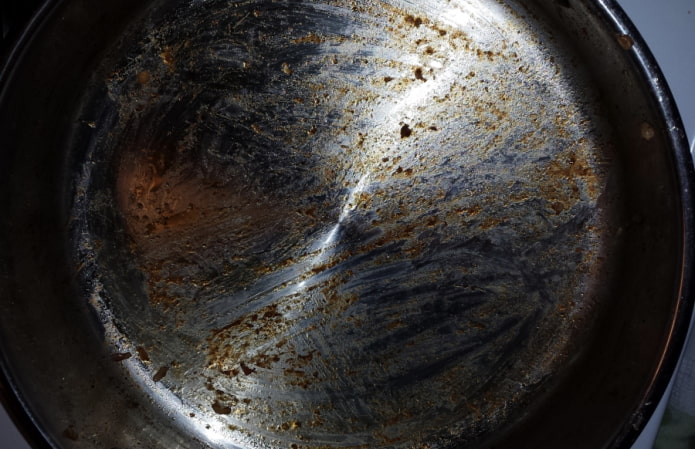
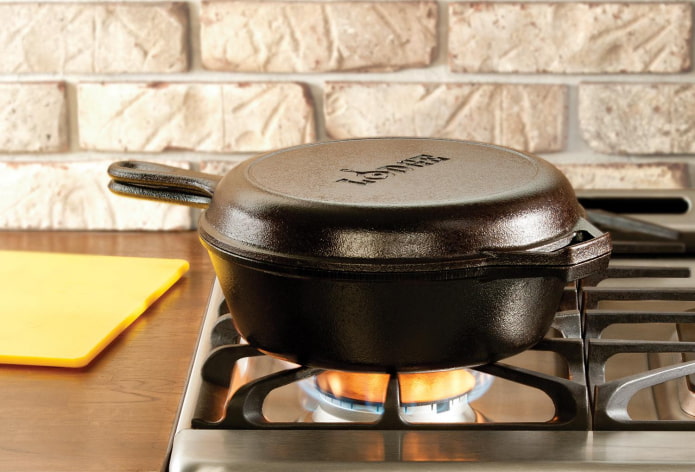
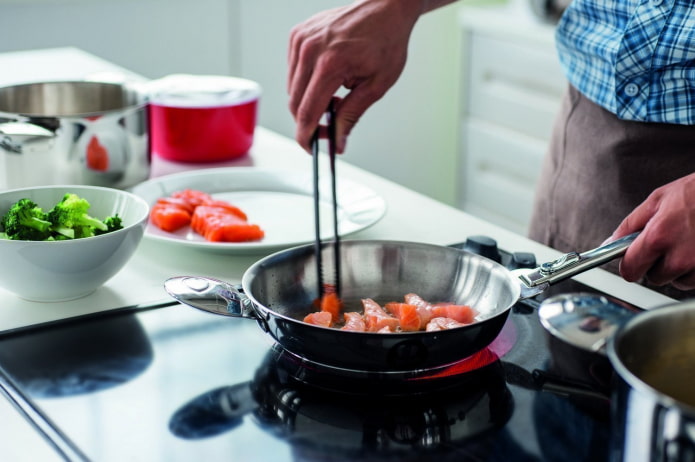

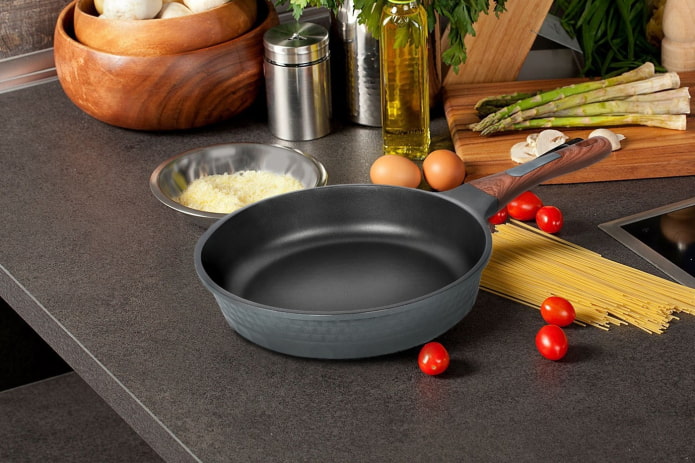
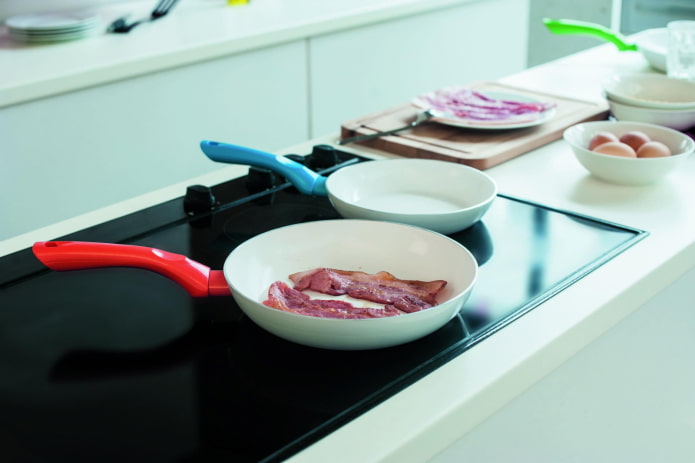
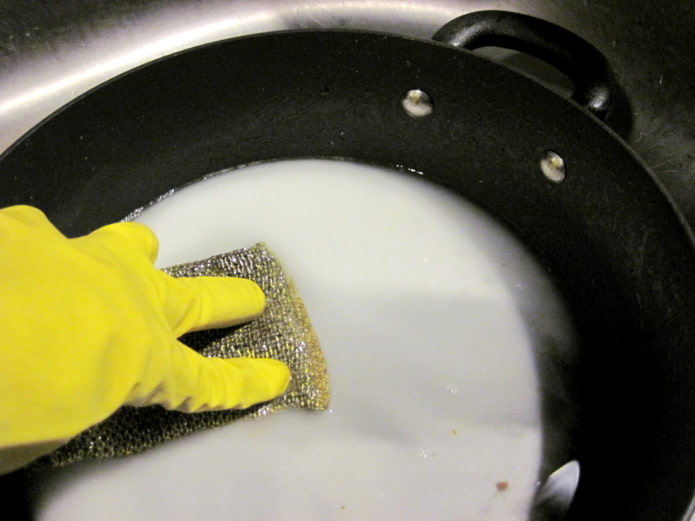
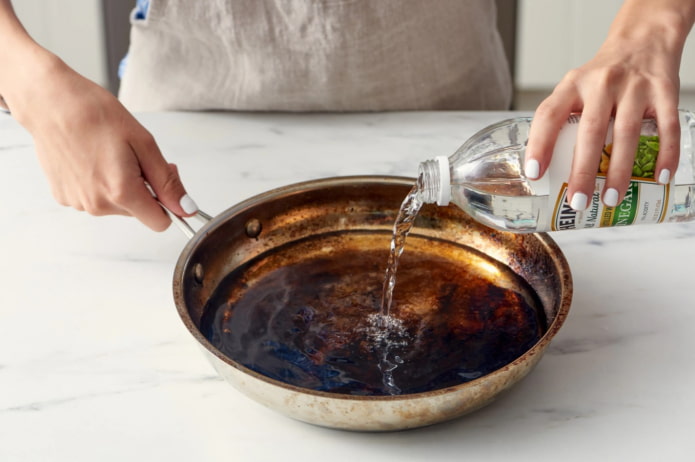

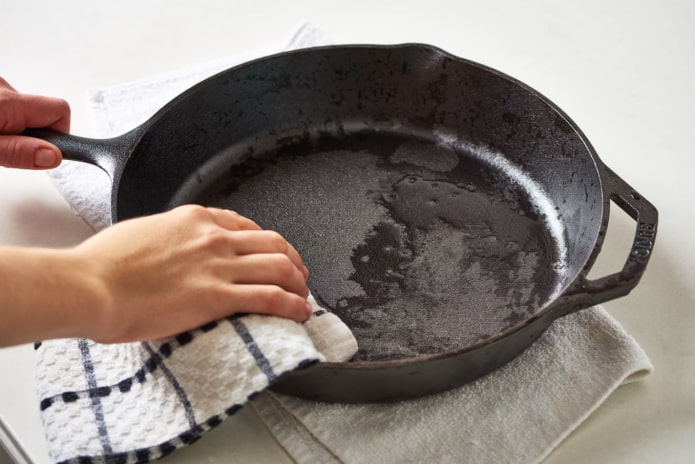
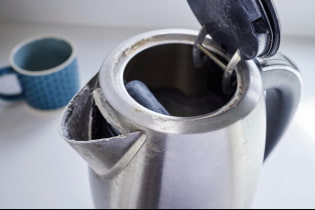 How to get rid of limescale in a kettle?
How to get rid of limescale in a kettle?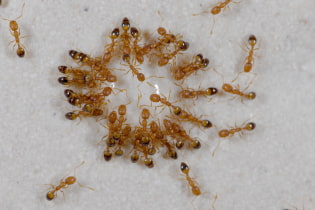 How to get rid of ants?
How to get rid of ants?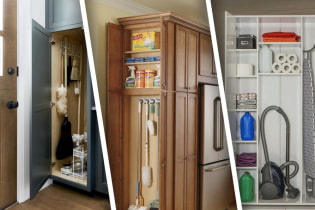 Where to store cleaning equipment?
Where to store cleaning equipment?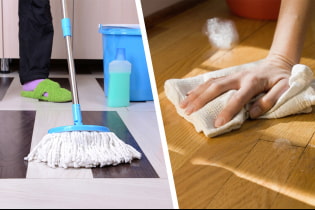 Is it better to mop the floor with your hands or with a mop?
Is it better to mop the floor with your hands or with a mop?